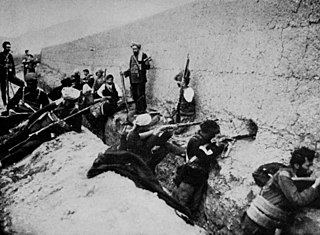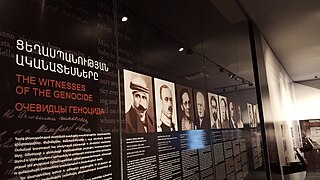
The Armenian genocide was the systematic destruction of the Armenian people and identity in the Ottoman Empire during World War I. Spearheaded by the ruling Committee of Union and Progress (CUP), it was implemented primarily through the mass murder of around one million Armenians during death marches to the Syrian Desert and the forced Islamization of others, primarily women and children.

James Bryce, 1st Viscount Bryce,, was a British academic, jurist, historian, and Liberal politician. According to Keoth Robbins, he was a widely traveled authority on law, government, and history whose expertise led to high political offices culminating with his successful role as ambassador to the United States, 1907–13. His intellectual influence was greatest in The American Commonwealth (1888), an in-depth study of American politics that shaped the understanding of America in Britain and in the United States as well.
The Ottoman Armenian population varied throughout history. The number of Armenians within the empire between 1914 and 1915 is a controversial topic. Most estimates by Western scholars range from 1.5 to 2.4 million. According to Britannica prior to 1915 and Samuel Cox, American Embassy in Istanbul from 1880-1886, it was 1.75 million and 2.4 million, respectively.

Ottoman Armenian casualties refers to the number of deaths of Ottoman Armenians between 1914 and 1923, during which the Armenian genocide occurred. Most estimates of related Armenian deaths between 1915 and 1918 range from 0.67 to 1.87 million.

Vahakn Norair Dadrian was an Armenian-American sociologist and historian, born in Turkey, professor of sociology, historian, and an expert on the Armenian genocide.

Halil Kut was an Ottoman military commander and politician. He served in the Ottoman Army during World War I, notably taking part in the military campaigns against Russia in the Caucasus and the British in Mesopotamia.

The defense of Van was the armed resistance of the Armenian population of Van against the Ottoman Empire's attempts to massacre the Ottoman Armenian population of the Van Vilayet in the 1915 Armenian genocide. Several contemporaneous observers and later historians have concluded that the Ottoman government deliberately instigated an armed Armenian resistance in the city and then used this insurgency as the main pretext to justify beginning the deportation and slaughter of Armenians throughout the empire. Witness reports agree that the Armenian posture at Van was defensive and an act of resistance to massacre. The self-defense action is frequently cited in Armenian genocide denial literature; it has become "the alpha and omega of the plea of 'military necessity'" to excuse the genocide and portray the persecution of Armenians as justified.

The occupation of Western Armenia by the Russian Empire during World War I began in 1915 and was formally ended by the Treaty of Brest-Litovsk. It was sometimes referred to as the Republic of Van by Armenians. Aram Manukian of Armenian Revolutionary Federation was the de facto head until July 1915. It was briefly referred to as "Free Vaspurakan". After a setback beginning in August 1915, it was re-established in June 1916. The region was allocated to Russia by the Allies in April 1916 under the Sazonov–Paléologue Agreement.
Djevdet Bey or Djevdet Tahir Belbez was an Ottoman Albanian governor of the Van vilayet of the Ottoman Empire during World War I and the Siege of Van. He is considered responsible for the massacres of Armenians in and around Van. Clarence Ussher, a witness to these events, reported that 55,000 Armenians were subsequently killed. He is also considered responsible for massacres of Assyrians in the same region.

Ara Sarafian is a British historian of Armenian origin. He is the founding director of the Gomidas Institute in London, which sponsors and carries out research and publishes books on modern Armenian and regional studies.

Jakob Künzler was a Swiss who resided in an oriental mission in Urfa and who witnessed the Armenian genocide.

The Memoirs of Naim Bey: Turkish Official Documents Relating to the Deportation and the Massacres of Armenians, containing the Talat Pasha telegrams, is a book published by historian and journalist Aram Andonian in 1919. Originally redacted in Armenian, it was popularized worldwide through the English edition published by Hodder & Stoughton of London. It includes several documents (telegrams) that constitute evidence that the Armenian genocide was formally implemented as Ottoman Empire policy.
The demographics of the Ottoman Empire include population density, ethnicity, education level, religious affiliations and other aspects of the population.

The Six Vilayets, the Six Provinces, or the Six Armenian Vilayets were the main Armenian-populated vilayets ("provinces") of the Ottoman Empire. These were Van, Erzurum, Mamuret-ul-Aziz, Bitlis, Diyarbekir and Sivas.

Witnesses and testimony provide an important and valuable insight into the events which occurred both during and after the Armenian genocide. The Armenian genocide was prepared and carried out by the Ottoman government in 1915 as well as in the following years. As a result of the genocide, as many as 1.5 million Armenians who were living in their ancestral homeland were deported and murdered.

The Gomidas Institute is an independent academic institution "dedicated to modern Armenian and regional studies." Its activities include research, publications and educational programmes. It publishes documents, monographs, memoirs and other works on modern Armenian history and organizes lectures and conferences. The institute was founded in 1992 at the University of Michigan in Ann Arbor. It is based in London and maintains a United States branch in Cleveland. British-Armenian historian Ara Sarafian serves as its executive director. Since 1998, the institute has been publishing a quarterly journal titled Armenian Forum. The institute is named after Komitas.

1915 is a 2015 American psychological thriller film written and directed by Garin Hovannisian and Alec Mouhibian. The film stars Simon Abkarian, Angela Sarafyan, Nikolai Kinski, Debra Christofferson, Jim Piddock, and Samuel Page. It follows a mysterious director staging a play to bring the ghosts of a forgotten tragedy back to life on the 100th anniversary of the Armenian genocide.
The Blue Book, Political Truth or Historical Fact is a 2009 documentary film by Gagik Karagheuzian about the Armenian genocide denial.
A Ottoman invasion of Persia took place in 1906 on the orders of the vali of Baghdad. On 23 May, the Ottomans occupied Behik in Bradest. By the end of May, Ottoman troops had occupied parts of Dasht and Mergaver districts, but not the settlement of Mergaver itself. By the 13th of June, the Ottomans had occupied Serdasht and Bani. Citizens of Khanakin were forced to take Ottoman passports and enlist in the Ottoman army. 500 mounted Ottoman troops marched from Baneh into the Persian Luristan country and the districts of Seifi, Malkhatavi and Baghasi, burning crops along the way. On 24 August, After protests were given by the Persian government, the Ottoman commander at Ban said he had no order to withdraw, and 2 days later the Ottomans were collecting Taxes near Urumia. On 8 September, the Ottomans occupied Gangatchin and the district of Baradosl. Ottoman troops subsequently occupied a strip of territory extending from a point south-west of Soujboulak to a point west of Khoi. On 3 August 1907, Mergaver was occupied and 3 days later the Ottomans threatened Urmia. The Ottomans were eventually expelled from Persia by the Russian Imperial Army in 1911.
Bibliography of the Armenian genocide is a list of books about the Armenian genocide:
















